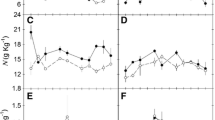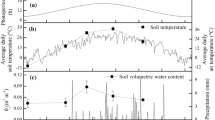Summary
Several aspects of photosynthetic adaptation to temperature were examined in four graminoid species from the Colorado shortgrass steppe. The experimental species were chosen to provide examples of a variety of in situ seasonal phenology patterns. The cool season grass, Agropyron smithii (C3), exhibited higher photosynthesis rates when grown in a cool temperature regime (20/15°C), and compared to warm grown plants (35/15°C). The warm season species, Bouteloua gracilis (C4) and Buchloe dactyloides (C4), exhibited higher photosynthetic capacities when grown in the warmer temperature regime. The sedge, Carex eleocharis (C3), which exhibits seasonal growth potential during the cool and warm portions of the growing season, exhibited a marked capacity for photosynthetic temperature acclimation. Differential effects of growth temperature on the intracellular conductance to CO2 appeared to have a greater regulatory role in these responses for the two C3 species, relative to stomatal conductance or photorespiration (O2 inhibition of photosynthesis). In the two C4 species decreases in the intracellular conductance in cool grown plants were correlated with the decreased photosynthetic capacity in normal air for B. gracilis, but not for B. dactyloides. Analysis of the Arrhenius relationship for CO2 saturated net photosynthesis at low leaf temperatures (4.5–17°C) indicated sharp breaks in the apparent energy of activation at 5.8–9.0°C in the warm season species B. gracilis and B. dactyloides. Leaves of A. smithii and C. eleocharis exhibited no significant low temperature limitations according to this analysis. The low temperature limitations in the warm season species were partially reflected in an inhibition of the quantum yield for CO2 uptake after 2 h at 5–6°C in the presence of high photon flux densities. Temperature dependent increases in the chlorophyll fluorescence yield at high temperatures revealed the lowest breakpoint values for A. smithii, and the highest values for B. gracilis. The differential patterns of temperature adaptation among the species further extend the proposal of Kemp and Williams (1980; Ecology 61:846–858) that seasonal temperature gradients in the shortgrass steppe have a regulatory role in maintaining offset patterns of resource utilization and decreasing interspecific competition.
Similar content being viewed by others
References
Badger MR, Björkman O, Armond PA (1982) An analysis of photosynthetic response and adaptation to temperature in higher plants: temperature acclimation in the desert evergreen Nerium oleander L. Plant, Cell and Environment 5:85–99
Berry J, Björkman O (1980) Photosynthetic temperature response and adaptation to temperature in higher plants. Ann Rev Plant Physiol 31:491–543
Björkman O, Mooney HA, Ehleringer JR (1975) Photosynthetic responses of plants from habitats with contrasting thermal environments. Carnegie Inst Wash Yearbook 74:743–748
Boutten TW, Harrison AT, Smith BN (1980) Distribution of biomass of species differing in photosynthetic pathway along an altitudinal transect in southeastern Wyoming grassland. Oecologia (Berlin) 45:287–298
Caemmerer S von, Farquhar GD (1981) Some relationships between the biochemistry of photosynthesis and the gas exchange of leaves. Planta 153:376–387
Caldwell MM, Osmond CB, Nott D (1977) C4 pathway photosynthesis at low temperature in cold-tolerant Atriplex species. Plant Physiol 60:157–164
Dickinson CE, Dodd JL (1976) Phenological pattern in the shortgrass prairie. Amer Midl Nat 96:367–378
Downton WJS, Seemann JR, Berry JA (1980) Thermal stability of photosynthesis in desert plants. Carnegie Inst Wash Yearbook 79:143–145
Edwards GE, Huber SC (1981) The C4 pathway. In: The Biochemistry of plants: a comprehensive treatise. VIII. Photosynthesis. Stumpf PK, Conn EE (eds) pp 238–282
Edwards GE, Walker DA Textbook on C3, C4 photosynthesis. Blackwell, Oxford (in press)
Ehleringer JR, Björkman O (1978) A comparison of photosynthetic characteristics of Encelia species possessing glabrous and pubescent leaves. Plant Physiol 62:185–190
Farquhar GD, Sharkey TD (1982) Stomatal conductance and photosynthesis. Ann Rev Plant Physiol 33:317–345
Gerwick BC, Williams GJ, III (1978) Temperature and water regulation of gas exchange of Opuntia polyacantha. Oecologia (Berlin) 35:149–159
Huber SC, Edwards GE (1977) Transport in C4 mesophyll chloroplasts: characterization of the pyruvate carrier. Biochim Biophys Acta 4:583–602
Jones HG, Slatyer RO (1972) Estimation of the transport and carboxylation components for the intracellular limitation to leaf photosynthesis. Plant Physiol 50:283–288
Kemp PR, Williams GJ, III (1980) A physiological basis for niche separation between Agropyron smithii (C3) and Bouteloua gracilis (C4). Ecology 61:846–858
Körner CH, Schul JA, Baur H (1979) Maximum leaf diffusive conductance in vascular plants. Photosynthetica 13:45–82
Ku SB, Edwards GE (1977) Oxygen inhibition of photosynthesis. II. Kinetic characteristics as affected by temperature. Plant Physiol 59:991–999
Longstreth DJ, Hartstock TL, Nobel PS (1980) Mesophyll cell properties for some C3 and C4 species with high photosynthetic rates. Physiol Plant 48:494–498
Monson RK (1982) Ecophysiological studies of three species from the Colorado shortgrass steppe: physiological factors regulating distribution in space and time. Dissertation. Washington State University p 183
Monson RK, Williams GJ, III (1982) A correlation between photosynthetic temperature adaptation and seasonal phenology patterns in the shortgrass prairie. Oecologia (Berlin) 54: 58–62
Monson RK, Stidham MA, Williams GJ III, Edwards GE, Uribe EG The temperature dependence of photosynthesis in Agropyron smithii Rydb. I. Factors affecting net CO2 exchange and contribution from RuBP carboxylase measured in vivo and in vitro. Plant Physiol 69: 921–928
Mooney HA, Björkman O, Collatz GJ (1978) Photosynthetic acclimation to temperature in the desert shrub, Larrea divaricata. I. Carbon dioxide exchange characteristics of intact leaves. Plant Physiol 6:406–410
Mooney HA, Björkman O, Ehleringer J, Berry J (1976) Photosynthetic capacity of in situ Death Valley plants. Carnegie Inst Wash Yearbook 75:410–413
Oulton KO (1979) Growth temperature effects on carboxylase enzymes from Agropyron smithii and Bouteloua gracilis. Dissertation. Washington State University p 80
Pearcy RW (1977) Acclimation of photosynthetic and respiratory CO2 exchange to growth temperature in Atriplex lentiformis (Torr.) Wats. Plant Physiol 59:795–799
Phillips PJ, McWilliam JR (1971) Thermal responses of the primary carboxylating enzymes from C3 and C4 plants adapted to contrasting temperature environments. In: Photosynthesis and Photorespiration Hatch MD, Osmond CB, Slatyer RO (eds) Wiley-Interscience, New York pp 97–104
Pike CS, Berry JA (1980) Membrane phospholipid phase separations in plants adapted to or acclimated to different thermal regimes. Plant Physiol 66:238–241
Powles SB, Berry JA, Björkman O (1980) Interaction between light intensity and chilling temperatures on inhibition of photosynthesis in chilling sensitive plants. Carnegie Inst Wash Yearbook 79:157–159
Regehr DL, Bazzaz FA (1976) Low temperature photosynthesis in successional winter annuals. Ecology 57:1297–1303
Robberecht R, Caldwell MM (1978) Leaf epidermal transmittance of ultraviolet radiation and implications for plant sensitivity to ultraviolet radiation induced injury. Oecologia (Berlin) 32:277–287
Schreiber U, Berry JA (1977) Heat-induced changes of chlorophyll fluorescence in intact leaves, correlated with damage of the photosynthetic apparatus. Planta 136:233–238
Seemann JR, Downton WJS, Berry JA (1979) Field studies of acclimation to high temperature: winter ephemerals in Death Valley. Carnegie Inst Wash Yearbook 78:159–162
Seemann JR, Tepperman JM, Berry JA (1981) The relationship between photosynthetic performance and the levels and kinetic properties of RuBP carboxylase-oxygenase from desert winter annuals. Carnegic Inst Wash Yearbook 80:67–72
Slatyer RO, Ferrar PJ (1977) Altitudinal variation in the photosynthetic characteristics of snow gum, Eucalyptus pauciflora Sieb. ex Spreng. II. Effects of growth temperature under controlled conditions. Aust J Plant Physiol 4:289–299
Smillie RM (1979) Coloured components of chloroplast membranes as intrisinc membrane probes for monitoring the development of heat injury in intact tissues. Aust J Plant Physiol 6:121–133
Sugiyama T, Boku K (1976) Differing sensitivity of pyruvate orthophosphate dikinase to low temperature in maize cultivars. Plant and Cell Physiol 17:851–854
Taylor AO, Craig AS (1971) Plants under climatic stress. II. Low temperature, high light effects on chloroplast ultrastructure. Plant Physiol 47:719–725
Williams GJ, III (1974) Photosynthetic adaptation to temperature in C3 and C4 grasses. A possible role in the shortgrass prairie. Plant Physiol 54:709–711
Author information
Authors and Affiliations
Rights and permissions
About this article
Cite this article
Monson, R.K., Littlejohn, R.O. & Williams, G.J. Photosynthetic adaptation to temperature in four species from the Colorado shortgrass steppe: a physiological model for coexistence. Oecologia 58, 43–51 (1983). https://doi.org/10.1007/BF00384540
Received:
Issue Date:
DOI: https://doi.org/10.1007/BF00384540




